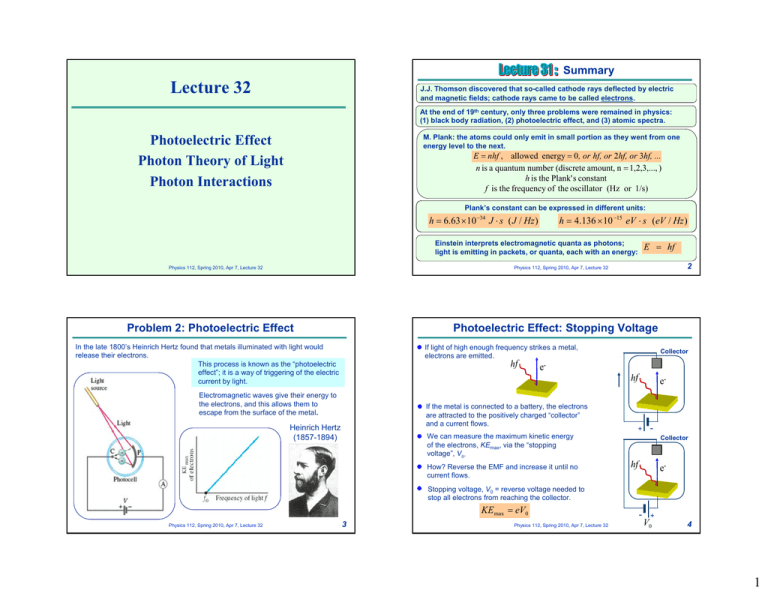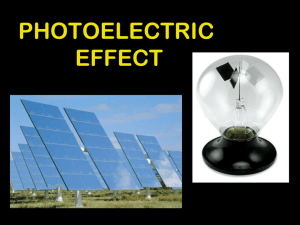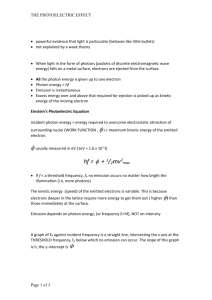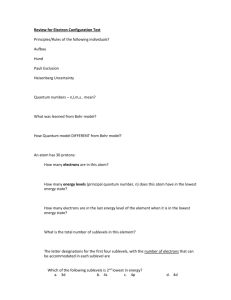Lecture 32
advertisement

Summary Lecture 32 J.J. Thomson discovered that so-called cathode rays deflected by electric and magnetic fields; cathode rays came to be called electrons. At the end of 19th century, only three problems were remained in physics: (1) black body radiation, (2) photoelectric effect, and (3) atomic spectra. M. Plank: the atoms could only emit in small portion as they went from one energy level to the next. Photoelectric Effect Photon Theory of Light Photon Interactions E = nhf , allowed energy = 0 , or hf, or 2hf, or 3hf, ... n is a quantum number (discrete amount, n = 1,2,3,..., ) h is the Plank' s constant f is the frequency of the oscillator (Hz or 1/s) Plank’s constant can be expressed in different units: h = 6.63 × 10 −34 J ⋅ s ( J / Hz ) h = 4.136 × 10 −15 eV ⋅ s (eV / Hz ) E = hf Einstein interprets electromagnetic quanta as photons; light is emitting in packets, or quanta, each with an energy: Physics 112, Spring 2010, Apr 7, Lecture 32 2 Physics 112, Spring 2010, Apr 7, Lecture 32 Problem 2: Photoelectric Effect Photoelectric Effect: Stopping Voltage In the late 1800’s Heinrich Hertz found that metals illuminated with light would release their electrons. This process is known as the “photoelectric effect”; it is a way of triggering of the electric current by light. If light of high enough frequency strikes a metal, electrons are emitted. hf Collector ehf Electromagnetic waves give their energy to the electrons, and this allows them to escape from the surface of the metal. If the metal is connected to a battery, the electrons are attracted to the positively charged “collector” and a current flows. Heinrich Hertz (1857-1894) e- + - We can measure the maximum kinetic energy of the electrons, KEmax, via the “stopping voltage”, V0. How? Reverse the EMF and increase it until no current flows. Collector hf e- Stopping voltage, V0 = reverse voltage needed to stop all electrons from reaching the collector. KE max = eV0 Physics 112, Spring 2010, Apr 7, Lecture 32 3 Physics 112, Spring 2010, Apr 7, Lecture 32 - + V0 4 1 Einstein’s Photon Theory vs. Wave Theory Photon Theory of Light (#1) Einstein suggested that, given the success of Planck’s theory, light must be emitted in small packets or “quanta” (particle). When a photon hits the metal it disappears; all its energy is transferred to the emitted e- (electrons). These tiny packets, or quanta, are called photons, each of energy: E = hf h f Is Plank’s constant Another Einstein’s bright idea how the energy and mass related to each other: (you need this equation for HW assignment) All photons have the same energy E = hf (if light is monochromatic). Work function, W0 = minimum energy needed to get an electron out of the metal (typically a few eV). E = mc 2 For photon energies below W0, no electrons are emitted. Wave theory: For photon energies above W0, the least tightly bound electrons will gain the most kinetic energy (KEmax): If the light intensity is increased, the number of electrons emitted and their kinetic energy should be increased. hf = KE max + W0 The frequency of the light should not affect the kinetic energy of emitted electrons. Only intensity should affect KEmax. 5 Photon Theory of Light (#2) Photon theory: If the frequency of the light is increased, the maximum kinetic energy of the electrons increases: KE max = hf − W0 If the frequency is less than the “cutoff” frequency f0, where hf0=W0, no electrons will be emitted, no matter how great the intensity of the light. KEmax of electrons varies linearly with frequency and does not depend on the intensity of the light. 6 Wave theory: 1. If the light intensity is increased, the number of electrons emitted increases, but their KEmax is unchanged. 1. The number of emitted electrons and KEmax both increase with intensity. 2. Below a “cutoff” frequency, f0, no electrons are emitted, regardless of the intensity. 2. There is no “cutoff” frequency. hf 0 = W0 3. KEmax increases linearly with frequency. Experiment shows clear agreement with the photon theory of light. Physics 112, Spring 2010, Apr 7, Lecture 32 Physics 112, Spring 2010, Apr 7, Lecture 32 Comparison of Photon and Wave Theories of Light An increase in intensity of the light means more photons so more electrons will be emitted; since the energy of each photon is not changed, the maximum kinetic energy is not changed by an increase in intensity. “Cutoff” frequency e- Energy is needed to overcome the attractive forces that hold the electron in the metal. is frequency of light Physics 112, Spring 2010, Apr 7, Lecture 32 hf 3. KEmax is independent of frequency. hf = KE max + W0 7 Physics 112, Spring 2010, Apr 7, Lecture 32 8 2 Photoelectric Effect Photoelectron Effect An electron is emitted from a sodium surface whose work function is W0=2.28 eV when illuminated by light with λ = 410 nm (blue). A metal surface is struck with light of λ = 400 nm, releasing a stream of electrons. The 400 nm light is replaced by λ = 300 nm light of the same intensity. What happened? 1. Photon energy: 1) more electrons are emitted in a given time interval E = hf = 2) less electrons are emitted in a given time interval 3) emitted electrons are more energetic hf = KE max + W0 c λ KE = KEmax increases linearly with frequency. vmax = mv 2 2 KE max = hf − W0 = 3.03 eV − 2.28 eV = 0.75 eV ( 2)(1.2 × 10 −19 J ) = 5.1× 10 5 m / s 9.1× 10 −31 kg 10 Compton fired X-rays at different materials. 1. Photon energy: Photon collides with an electron in the material, knocking it out of its atom. ( 4.14 × 10 −15 eV ⋅ s )(3 × 10 8 m / s ) E = hf = = = 1.77 eV 700 × 10 −9 m λ hc Compton found that the wavelength of scattered photon was longer than the incident ones, and that the wavelength depended on the scattering angle, φ. Since this photon energy is less than the work function, no electrons are emitted from a sodium surface. Photoelectric Effect λ'= λ + What is the longest wavelength of light that will emit electrons from a metal whose work function is 3.10 eV? h c λ h (1 − cos φ ) m0 c E = hf = h = W0 hc ( 4.14 × 10 −15 eV ⋅ s )(3 × 10 8 m / s ) = = 4 × 10 − 7 m = 400 nm 3.1 eV W0 Physics 112, Spring 2010, Apr 7, Lecture 32 2 KE max = m Compton Effect An electron is emitted from a sodium surface whose work function is W0=2.28 eV when illuminated by light with λ = 700 nm (red). hf = 0 + W0 = W0 vmax = Physics 112, Spring 2010, Apr 7, Lecture 32 Photoelectric Effect KE max = 0 KE = 0.75 eV = (0.75eV )(1.6 × 10 −19 J / ev ) = 1.2 × 10 −19 J 2 KE max m 9 Physics 112, Spring 2010, Apr 7, Lecture 32 λ= ( 4.14 × 10 −15 eV ⋅ s )(3 × 10 8 m / s ) = 3.03 eV 410 × 10 −9 m 3. Speed of emitted electron: KE max = hf − W0 hf = KE max + W0 λ = 2. Maximum kinetic energy of emitted electron: 4) emitted electrons are less energetic f = hc c λ This implies that the photon’s frequency and energy is smaller after the collision. Wave theory of light predicts no such change in wavelength. 11 Physics 112, Spring 2010, Apr 7, Lecture 32 12 3 Photon Interactions Process 4: Electron-Positron Pair Production Photons passing through matter can result in four types of interactions: In pair production, energy, E, charge, q, and momentum, p, are conserved. 2. Atomic excitation: photon is totally absorbed and an electron is promoted to a higher energy level in atom. e- hf 1. Photoelectric effect: photon is completely absorbed and an electron is emitted. e- 3. Compton effect: photon scatters from an electron and loses energy. Energy conservation: Photon disappears; its energy is converted into the rest mass of the particles (electron and positron). e- φ A positron has the same mass as an electron but the opposite charge: +e. hf e+ nucleus e- Physics 112, Spring 2010, Apr 7, Lecture 32 Charge conservation: If an electron is created, we also create a positron (same mass but opposite charge). matter electron Momentum conservation: Pair production must take place near a heavy object, e.g. a nucleus, which carries away the momentum of the photon. hf' 4. Pair production: photon creates matter, e.g. an electron-positron pair. antimatter Any excess energy is converted into kinetic energy of the particles. hf hf positron Electron-positron annihilation is the opposite process. If an electron collides with a positron, the two annihilate each other and their energy and mass, appears as electromagnetic energy of photons. 13 Physics 112, Spring 2010, Apr 7, Lecture 32 Pair Production 14 Quantum Hypothesis What is the minimum energy of a photon and photon’s wavelength that can produce an electron-positron pair? What does it mean for something to be “quantized”: 1. Photon energy: E = m0 c 2 = ( 2)(9.1 × 10 −31 kg )(3 × 10 8 m / s ) 2 = 1.64 × 10 −13 J = 1.02 MeV 2) in can have any value in certain region 1 MeV = 10 6 eV = 1.6 × 10 −13 J 1 eV = 1.6 × 10 −19 J 1) it can have only certain discrete value 3) it can have values only between certain limits 2. Photon wavelength: 4) none of the above E = hf = λ= hc λ hc λ= E −34 (6.63 × 10 J ⋅ s )(3 × 10 8 m / s ) = 1.2 × 10 −12 m 1.64 × 10 −13 J Physics 112, Spring 2010, Apr 7, Lecture 32 15 Physics 112, Spring 2010, Apr 7, Lecture 32 16 4



